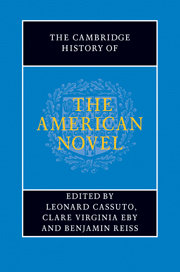Book contents
- Frontmatter
- General Introduction
- PART ONE INVENTING THE AMERICAN NOVEL
- PART TWO REALISM, PROTEST, ACCOMMODATION
- Introduction: realism, protest, accommodation
- 17 Realism and radicalism: the school of Howells
- 18 James, pragmatism, and the realist ideal
- 19 Theories of the American novel in the age of realism
- 20 The novel in postbellum print culture
- 21 Twain, class, and the Gilded Age
- 22 Dreiser and the city
- 23 Novels of civic protest
- 24 Novels of American business, industry, and consumerism
- 25 New Americans and the immigrant novel
- 26 Cather and the regional imagination
- 27 Wharton, marriage, and the New Woman
- 28 The postbellum race novel
- 29 The African American novel after Reconstruction
- 30 The rise of naturalism
- 31 Imagining the frontier
- 32 Imperialism, Orientalism, and empire
- 33 The hemispheric novel in the post-revolutionary era
- 34 The woman's novel beyond sentimentalism
- 35 Dime novels and the rise of mass-market genres
- 36 Readers and reading groups
- PART THREE MODERNISM AND BEYOND
- PART FOUR CONTEMPORARY FORMATIONS
- A selected bibliography
- Index
21 - Twain, class, and the Gilded Age
from PART TWO - REALISM, PROTEST, ACCOMMODATION
Published online by Cambridge University Press: 28 July 2011
- Frontmatter
- General Introduction
- PART ONE INVENTING THE AMERICAN NOVEL
- PART TWO REALISM, PROTEST, ACCOMMODATION
- Introduction: realism, protest, accommodation
- 17 Realism and radicalism: the school of Howells
- 18 James, pragmatism, and the realist ideal
- 19 Theories of the American novel in the age of realism
- 20 The novel in postbellum print culture
- 21 Twain, class, and the Gilded Age
- 22 Dreiser and the city
- 23 Novels of civic protest
- 24 Novels of American business, industry, and consumerism
- 25 New Americans and the immigrant novel
- 26 Cather and the regional imagination
- 27 Wharton, marriage, and the New Woman
- 28 The postbellum race novel
- 29 The African American novel after Reconstruction
- 30 The rise of naturalism
- 31 Imagining the frontier
- 32 Imperialism, Orientalism, and empire
- 33 The hemispheric novel in the post-revolutionary era
- 34 The woman's novel beyond sentimentalism
- 35 Dime novels and the rise of mass-market genres
- 36 Readers and reading groups
- PART THREE MODERNISM AND BEYOND
- PART FOUR CONTEMPORARY FORMATIONS
- A selected bibliography
- Index
Summary
In 1865, with the South defeated and the peculiar institution of slavery finally eradicated, American capitalism had what Vernon Parrington called “its first clear view of the Promised Land.” Liquid capital which had accumulated in Philadelphia and New York banks during the war could now be released into railroads, stockyards, refineries, and mills. Suddenly, there were vast new fortunes to be made from livestock, timber, steel, petroleum, and wheat, as well as unparalleled opportunities for corruption. America may have been a “vast, uniform middle-class land,” in which every citizen was putatively “dedicated to capitalism,” but government subsidies, tariffs, and land-grants were carefully steered toward the corporate elite, in what Parrington dubbed “the great barbecue.” Most notoriously, the Philadelphia banker, Jay Cooke, obtained 50 million acres of western lands for his Northern Pacific Railroad and established a separate company, the Credit Mobilier, to channel subsidies directly into the pockets of company directors, while the railroad's coffers were opened to provide Republicans with sweeteners in the form of campaign money and railroad stock. Ordinary Americans had believed in an open society, one that was competitive and fiuid, in which entrepreneurial energy and ingenuity would be rewarded. Now it appeared that “amoral wealth-seekers” were blocking access to the “social escalator.” An onlooker at this spectacle was Samuel Langhorne Clemens, who, as Mark Twain, became both a sharp critic of capitalist excess and the virtual spokesman for a confused and contradictory middle class, buffeted and transformed by the period he named the Gilded Age.
- Type
- Chapter
- Information
- The Cambridge History of the American Novel , pp. 365 - 379Publisher: Cambridge University PressPrint publication year: 2011



